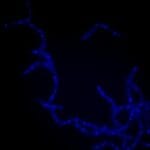 Diseases such as tuberculosis, anthrax, and shigellosis could eventually be treated with an entirely new and more effective kind of antibiotic, thanks to a team of scientists led by researchers at Penn State University.
Diseases such as tuberculosis, anthrax, and shigellosis could eventually be treated with an entirely new and more effective kind of antibiotic, thanks to a team of scientists led by researchers at Penn State University.
In a research paper published in the Proceedings of the National Academy of Sciences journal this week, the team describes 46 previously untested molecules that target and disrupt an important step in the process of protein synthesis in bacteria, thereby rendering bacteria incapable of replicating.
This step, known as trans-translation, is a “quality control” mechanism that is found in all species of bacteria and that other life forms, such as plants and animals, do not seem to use.
“If you imagine the bacterial protein-synthesis pathway as a factory assembly line, trans-translation is responsible for keeping the assembly line moving. Faulty messenger RNA (mRNA) — which is RNA that conveys genetic information from DNA to proteins — can block the synthesis machinery. Trans-translation removes these blocks from the assembly line, thereby keeping the system running smoothly,” explains Kenneth Keiler, an associate professor of biochemistry and molecular biology at Penn State University. “Were it not for trans-translation, all the subsequent steps in the factory assembly line would get held up and the organism would not be able to function properly — synthesizing the proteins that it needs for survival.”
Since discovering this critical trans-translation step in 1996, Keiler has been working toward the goal of finding molecules capable of disrupting this particular stage of the protein-synthesis pathway. “The idea is that if we can disturb trans-translation — bacteria’s quality-control step — then we can throw a wrench into the protein-synthesis assembly line and prevent the organisms from making copies of themselves,” Keiler said.
To discover which small molecules might be capable of disrupting trans-translation, the team used high-throughput screening to test approximately 663,000 different molecules targeted at E. coli, identifying 46 candidates that appeared to be effective in the disruption of trans-translation.
The team then tested these candidates to assess efficacy at disturbing trans-translation in other bacteria that are known to cause illness, namely Shigella — a genus of bacteria that causes food poisoning and that is related to Salmonella — and Bacillus anthracis — the organism that causes anthrax, which sometimes can be lethal in humans and other animals.
“Of the 46 molecules that were shown to affect trans-translation, one called KKL-35 jumped out as the most promising,” Keiler said. “We found that it inhibits the growth of very distantly related bacteria, and this suggests that it may have antibiotic activity against a very broad spectrum of species. As for Shigella and Bacillus anthracis, we were able to show that, in the presence of KKL-35, the cells died specifically because the molecule halted the trans-translation process.”
Keiler noted that one of the most exciting features of an antibiotic designed from KKL-35 concerns the unlikeliness of drug resistance in mutant strains of bacteria. “In our laboratory experiments, we found no mutant strains that were resistant to KKL-35,” Keiler said. “One possible explanation for the lack of resistant mutants in lab experiments is that changes in trans-translation molecules that disrupt drug binding also eliminate trans-translation activity. Resistant mutants probably would evolve eventually, but at least it looks like it will be very difficult. That means resistant mutants might be slow to arise and spread.”
Image: Bacillus anthracis (anthrax) cells are being killed by one of the disruptor molecules identified by Penn State researchers. The molecule is naturally fluorescent, and it looks blue when it is excited by ultraviolet light in the microscope. (Keiler Lab, Penn State University).
Source: Penn State University


